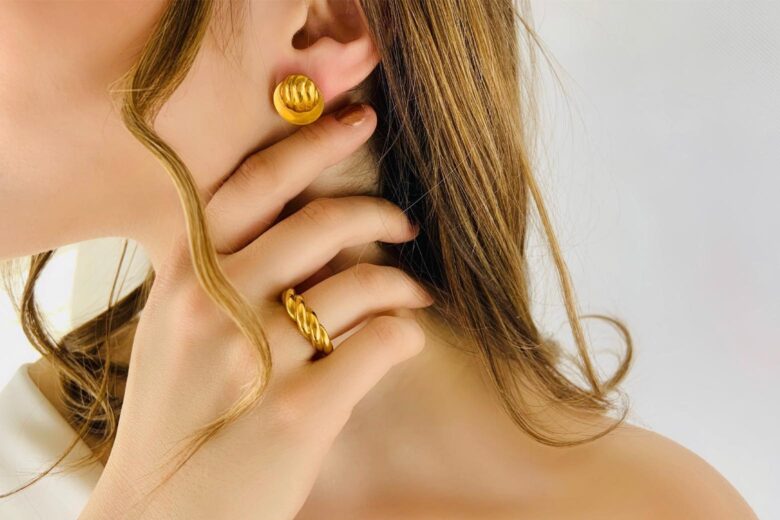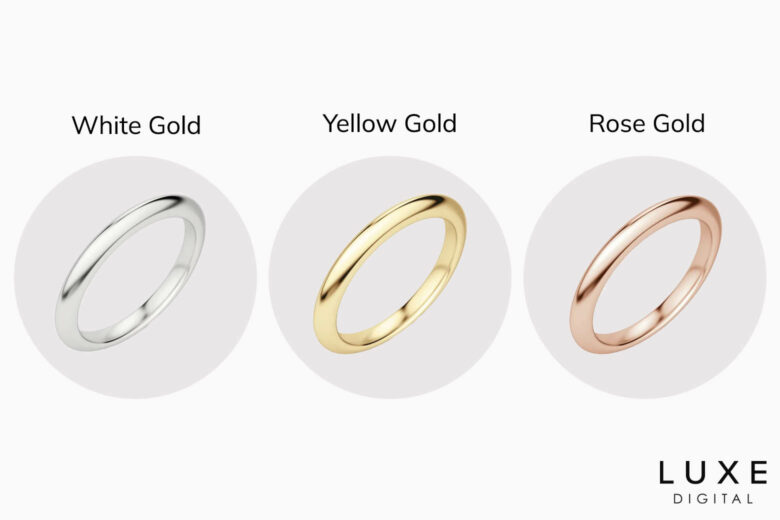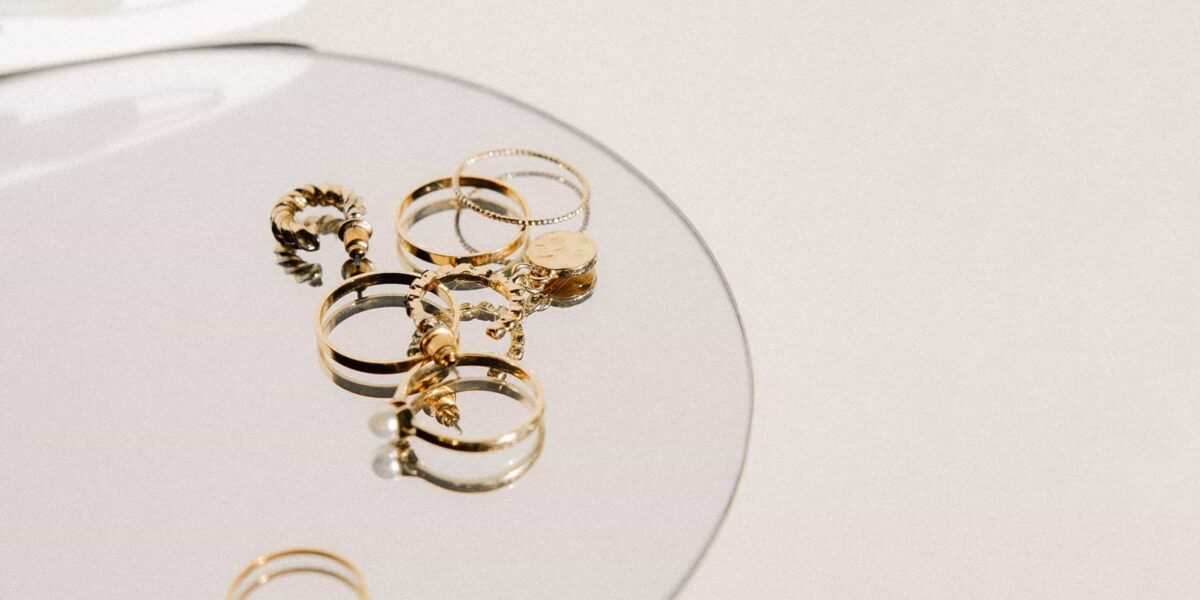We all know the saying: all that glitters is not gold. And while we appreciate the heads up, it doesn’t really help us determine what is gold and what is not. What is 14k gold or 18k gold made of? Is it always better to opt for higher karatages? Or can you get away with gold plated or gold vermeil? If these are the questions running through your mind at Tiffany’s or Bulgari, you’re not alone.
And when you’re about to invest in future heirlooms, they’re questions well worth paying attention to.
Let’s start with the (not so simple) basics: what is gold? Or rather, what is solid gold?

What is solid gold
Solid gold, pure gold—surely they’re the same thing? Not quite. Solid gold is alloyed with different ratios of other metals, while pure gold isn’t. Also known as “fine gold,” pure gold is 24 karats and is as pure as it gets for gold jewelry.
However, pure gold jewelry is extremely rare. And not just because it is very expensive but rather because pure gold is considered to be too soft for jewelry production in the United States and worldwide. Therefore most fine jewelry is manufactured from gold alloys—otherwise called solid gold.
Read our in-depth guide to gold purity to understand gold karats.
Thankfully there are still rules for what constitutes “real gold” and what doesn’t. In order to be considered “real gold”, solid gold jewelry must have a karatage of 9 or higher. Karatage is the measurement of gold in alloys. 24 Karat gold jewelry is the purest form of real gold jewelry. And anything below that indicates the percentage of gold found in the alloy.
18K gold contains 75% pure gold and 25% other metals. It is also typically the highest form of gold used for solid gold jewelry by the best jewelry brands. 14K gold only contains 58% gold and 42% other metals. However, it is considered the best value form of solid gold and is the most popular addition to designer jewelry organizers—especially in the United States.

Shades of gold
Still looking for the pot of gold at the end of the rainbow? You may just be searching for the wrong shade. Like the rainbow itself, solid gold comes in a myriad of hues. Real gold jewelry does too—yep, green and blue golds do exist—but the most popular shades by far are yellow gold, white gold, and rose gold.
Interested in learning more? Check our detailed guide to gold colors comparing white gold to yellow gold and rose gold.
Yellow gold
Pure gold is always yellow. But yellow gold isn’t always pure. In fact, most of it isn’t.
In order to be considered durable enough for everyday use, most gold jewelry is alloyed with other metals. These metals determine the strength and quality of the gold, as well as its hue. Yellow gold jewelry is usually mixed with equal parts copper and silver and a small amount of zinc. These metals alter the color slightly, but maintain a yellow hue.
18K gold contains more pure gold and will be a richer shade of yellow than 14K gold and 10K gold, which are much lighter in hue.
White gold
A timeless choice for everyday classical necklaces and engagement rings, white gold is considered to be both elegant and durable.
White gold looks similar to sterling silver, but it is more white than gray.
White gold can be mixed with different quantities of copper, silver, nickel and palladium—each of which alters the hue of the precious metal slightly. For instance, palladium white gold is slightly more gray than nickel bearing white gold. And 18K white gold is more yellow than 14K white gold.
Rose gold
Although rose gold—also known as Russian gold—was most popular in 19th-century Russia, it’s making a big comeback in contemporary gold jewelry.
Rose gold is combined with the same metals used in yellow gold—copper, silver and zinc—but in different proportions. The rose tint is achieved by greater proportions of copper, which also gives the precious metal its superlative strength and durability.
Considered the middleman between gold and silver, rose gold is great for harmonizing yellow and white jewelry, making it a popular choice for the best everyday bracelets, rings, and watches.

Alternatives to solid gold jewelry
Solid gold is most popular for high quality fine jewelry. But there are many more affordable types of gold too. Unlike solid gold jewelry, these gold alternatives have different base metals.
Gold Plated
Gold plated jewelry is one of the most common types of gold used in fashion jewelry. And whilst it’s a great affordable option for once-off statement pieces, gold plated jewelry is not regulated and can have any base metal.
It also usually has a very fine (0.5 microns thick) layer of gold. This means that it can tarnish and wear off within weeks of heavy wear. If you plan on wearing a piece more than once or twice, we recommend investing in higher-quality gold jewelry.
Gold-Filled
Gold-filled jewelry is a lot more expensive than gold-plated jewelry, but don’t let the price fool you. Gold-filled jewelry is in fact, not filled with gold. Rather, it refers to an old-fashioned method of mechanically bonding a thin layer of gold to a base metal. This method is more costly than modern electroplating, making gold-filled jewelry more expensive than gold-plated jewelry but with little added value.
The only upside of gold-filled jewelry is that it is regulated and 5% of the alloy must be solid gold, although you’d still be better off with gold vermeil.
Gold Vermeil
Gold vermeil is the highest quality gold you can get without buying solid gold jewelry. Regulated by the Federal Trade Commission of the United States, all gold vermeil must have a layer of gold that is at least 2.5 microns thick of gold that is at least 10K plated onto sterling silver (and no other base metal).
These regulations guarantee quality gold jewelry that is durable and long lasting without costing the earth. Plus, gold vermeil is hypoallergenic, making it a popular choice for more affordable high-end earrings and other quality gold jewelry.
Caution: What is Fool’s Gold?
As the central theme of the 2008 film starring Matthew McConaughey and Kate Hudson, fool’s gold is not quite as fun to invest in as it is to watch. Fool’s gold refers to minerals that look like gold but have absolutely no value.
The most common minerals used to fool buyers into buying fake gold are pyrite, chalcopyrite and mica. And whilst these minerals may appear appealing at a first glance, they flake, powder or crumble when poked, making them delicate and short-lived.
If you’re unsure of whether the gold seller is reputable or not, try the streak test to avoid investing in nothing of value. If the “gold jewelry” doesn’t leave a golden yellow streak when scraped on unglazed porcelain, the piece isn’t real gold, and you needn’t investigate further.
Frequently asked questions about solid gold
Solid gold jewelry is good if you want something durable. Although solid gold isn’t pure gold, most luxury jewelry brands use solid gold to create more durable pieces. Solid gold is pure gold mixed with other metals. The karatage indicates the percentage of pure gold to other metals, as well as the value of the piece. 18K Gold jewelry is 75% pure gold and 25% other metals, while 14K Gold is 58% pure gold and 42% other metals.
Yes, all solid gold jewelry is considered real gold. Although solid gold is a combination of pure gold (24K gold) and other metals, all solid gold must have a karatage of 9 or more to be defined as such. Most real gold jewelry is actually solid gold, as pure gold is considered too soft to produce jewelry for everyday wear.
Gold loosely refers to any form of gold jewelry, including gold-plated jewelry, gold-filled jewelry and gold vermeil jewelry. These gold alternatives can include very little gold and are not always considered “real gold.” Solid gold jewelry on the other hand has to have a karatage of 9 or more and the substance must be uniform throughout the piece. In other words, it cannot have another base metal.
Solid gold is the highest form of quality gold jewelry, making it more expensive than any other gold alternative. But not all solid gold is of equal value. The higher the karatage, the higher the percentage of pure gold and the higher the price. For example, 18K solid gold is more expensive than 14K solid gold. Read our guide to gold purity to learn more.










